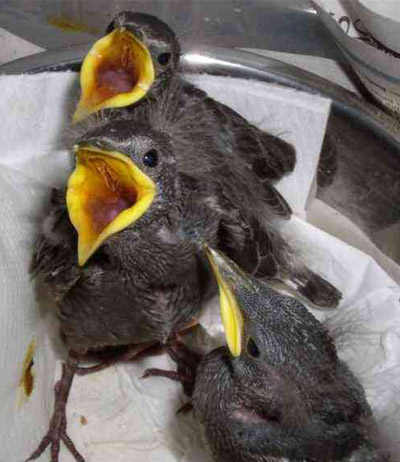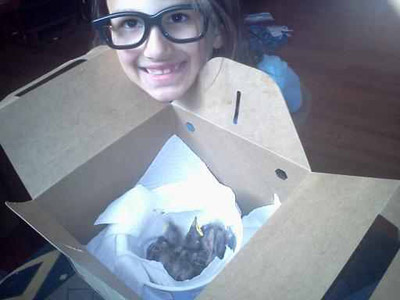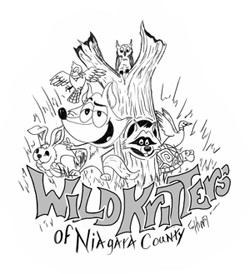The Adventures of New Rehabbers
 We got to their home shortly after 2p.m. and it was perfect timing! All the babies were hungry, so Niamh started with a tiny syringe of squirrel formula and fed the one squirrel who remains in the house for close supervision. She might have fallen out of the tree that her home was in when it was cut down and possibly suffers from some neurological issues. She shakes when she moves and has difficulty balancing herself. With some difficulty latching on, little squirrely finally started suckling from Niamh's syringe and gobbled up all her food! Then it was time to meet the baby Starlings! In their nest, snuggled closely together for warmth, 5 little Starlings starting crying for their food. What is this?! The Ugly Duckling?! There was a 6th baby bird, featherless and about a quarter of the Starlings' size. Brenda explained to us that he was a completely different bird and she wasn't quite sure what his particular species was yet. Brenda needed to hold him to feed but the little Starlings, now feathered and moving a wee bit, stuck their heads out high up in the sky as Brenda dropped mushy dog food into their crop (Actually, I couldn't remember this word and just asked Niamh now, if she remembered the word Brenda taught us - the part of the neck where the babies store their food and ingest a little at a time. Without skipping a beat, Niamh answered, crop. Niamh's ability to listen to details and retain information is uncanny. Sometimes people mistake her for not listening as she may be looking somewhere else, but she is listening to every word. My ability to retain information? Eh, not so much!).
We got to their home shortly after 2p.m. and it was perfect timing! All the babies were hungry, so Niamh started with a tiny syringe of squirrel formula and fed the one squirrel who remains in the house for close supervision. She might have fallen out of the tree that her home was in when it was cut down and possibly suffers from some neurological issues. She shakes when she moves and has difficulty balancing herself. With some difficulty latching on, little squirrely finally started suckling from Niamh's syringe and gobbled up all her food! Then it was time to meet the baby Starlings! In their nest, snuggled closely together for warmth, 5 little Starlings starting crying for their food. What is this?! The Ugly Duckling?! There was a 6th baby bird, featherless and about a quarter of the Starlings' size. Brenda explained to us that he was a completely different bird and she wasn't quite sure what his particular species was yet. Brenda needed to hold him to feed but the little Starlings, now feathered and moving a wee bit, stuck their heads out high up in the sky as Brenda dropped mushy dog food into their crop (Actually, I couldn't remember this word and just asked Niamh now, if she remembered the word Brenda taught us - the part of the neck where the babies store their food and ingest a little at a time. Without skipping a beat, Niamh answered, crop. Niamh's ability to listen to details and retain information is uncanny. Sometimes people mistake her for not listening as she may be looking somewhere else, but she is listening to every word. My ability to retain information? Eh, not so much!).
Brenda then decided that being new rehabbers, we would start with three baby birds. We got our babies ready in their carrying case, sat down at the kitchen table and learned a little more about how to care for our new little ones:
- Always ensure that they are WARM and never feed them if they are COLD.
- They can eat either cat or dog food by mixing it with boiling water until it becomes the consistency of soft, oatmeal chunks.
- They are now at the stage where they will need to be fed every 30 minutes but we can take them wherever we go (This was a big deal as we are always on the go!)
- Regularly clean their nest and carrying case as baby Starlings do three things very well: Eat, Sleep and Poop! (Remind anyone of their own human newborns?!)
- Do NOT talk to them in cutsie baby talk. In fact, try not to talk to them at all as they will imprint on you and then they and you both, have a problem. (Imprinting is when baby birds identify with whatever or whomever is feeding them. If it happens to be a human, when it comes time for soft or hard release, they will not want to leave you and you will find them nesting behind a wheel of your car or pooping on you - close by - waiting for you to feed them. Imprinting on humans also means the birds will be susceptible to dangers as they will feel no fear approaching humans and other creatures, putting them in potentially life-threatening situations).
- As they grow, they will begin to perch themselves on the lip of their little nest and will need to be placed in an actual cage, with branches and a food dish.
- Gradually teach them to feed independently from the dish by placing the food by hand, closer and closer to the dish.
- When the birds are eating independently from the dish and moving freely about the cage, it will be time for soft release - we bring them to a safe place, open the cage and allow them to search for their own food. The cage remains open so that they can come back to rest and eat should they feel the need. Eventually, they will fly away and start to live their independent Starling life.
** I have also read that it is extremely important for whatever species of bird you have, to hear their song. For us, that will mean that our birds need to hear mature Starlings singing so that they can identify with (imprint) their own song and be accepted into the Starling family in the wild.
 With our lesson over, we headed to the car with our new baby birds and started our trip back home. Before we arrived home, the baby birds needed to feed. Just like a natural mama, Niamh opened their box and fed each one of them until they once again quieted down into a newborn sleepy state and fell back to sleep. The afternoon and night was AMAZING! My daughter has truly become a mama bird! Over the course of our first day and night, Niamh set the timer every 30 minutes, changed their bedding, ensured each of the three birds had been properly fed and by 9:00p.m., placed a towel over their case for extra darkness and the babies slept - right through the night! Niamh is puffing with pride! She is glowing and elated with having been given the awesome responsibility of caring for dependent birds and I am spilling over with love. Here are some amazing feelings that my daughter has shared with the family:
With our lesson over, we headed to the car with our new baby birds and started our trip back home. Before we arrived home, the baby birds needed to feed. Just like a natural mama, Niamh opened their box and fed each one of them until they once again quieted down into a newborn sleepy state and fell back to sleep. The afternoon and night was AMAZING! My daughter has truly become a mama bird! Over the course of our first day and night, Niamh set the timer every 30 minutes, changed their bedding, ensured each of the three birds had been properly fed and by 9:00p.m., placed a towel over their case for extra darkness and the babies slept - right through the night! Niamh is puffing with pride! She is glowing and elated with having been given the awesome responsibility of caring for dependent birds and I am spilling over with love. Here are some amazing feelings that my daughter has shared with the family:
Dad, Carleigh and Shannon are going to be PSYCHED!
Mom, I could be sitting at a DESK right now but I'm taking care of baby birds!
We are both mamas now, mom!
Shannon, please come see the baby birds; I'll tell you all about them.
Dad, do you want to see me feeding them?
When the baby birds were put to bed for our first night, we sat around the fire, contemplating our day. I could literally write a book alone, on how Niamh is not only rising to this new challenge, but about the development of pride, strength, independence, self-esteem - the list goes on and on and on. You know that look on a new mother's face that radiates from within?
That is Niamh, our mama bird.
Click here to visit Carreen and Niamh Schroeder and all of their Homeschooling Adventures >>

